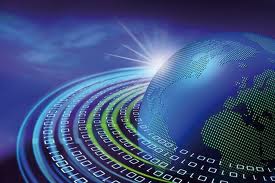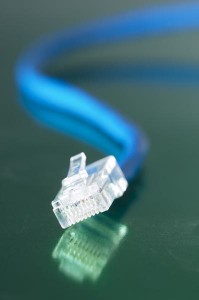Types of Broadband Access

Digital Subscriber Line (DSL)
DSL is a wireline transmission technology that transmits data faster over traditional copper telephone lines already installed to homes and businesses. DSL-based broadband provides transmission speeds ranging from several hundred Kbps to millions of bits per second (Mbps). The availability and speed of your DSL service may depend on the distance from your home or business to the closest telephone company facility.
The following are types of DSL transmission technologies:
Asymmetrical Digital Subscriber Line (ADSL) – Used primarily by residential customers, such as Internet surfers, who receive a lot of data but do not send much. ADSL typically provides faster speed in the downstream direction than the upstream direction. ADSL allows faster downstream data transmission over the same line used to provide voice service, without disrupting regular telephone calls on that line.
Symmetrical Digital Subscriber Line (SDSL) – Used typically by businesses for services such as video conferencing, which need significant bandwidth both upstream and downstream.
Faster forms of DSL typically available to businesses include:
High data rate Digital Subscriber Line (HDSL); and
Very High data rate Digital Subscriber Line (VDSL).
Types of Broadband Connections – Broadband.gov. (n.d.). Retrieved September 18, 2013, from http://www.broadband.gov/broadband_types.html

Cable modem service enables cable operators to provide broadband using the same coaxial cables that deliver pictures and sound to your TV set.
Most cable modems are external devices that have two connections: one to the cable wall outlet, the other to a computer. They provide transmission speeds of 1.5 Mbps or more.
Subscribers can access their cable modem service by simply turning on their computers, without dialing-up an ISP. You can still watch cable TV while using it. Transmission speeds vary depending on the type of cable modem, cable network, and traffic load. Speeds are comparable to DSL.
Types of Broadband Connections – Broadband.gov. (n.d.). Retrieved September 18, 2013, from http://www.broadband.gov/broadband_types.html

- Fiber optic technology converts electrical signals carrying data to light and sends the light through transparent glass fibers about the diameter of a human hair. Fiber transmits data at speeds far exceeding current DSL or cable modem speeds, typically by tens or even hundreds of Mbps.
- The actual speed you experience will vary depending on a variety of factors, such as how close to your computer the service provider brings the fiber and how the service provider configures the service, including the amount of bandwidth used. The same fiber providing your broadband can also simultaneously deliver voice (VoIP) and video services, including video-on-demand.
- Telecommunications providers sometimes offer fiber broadband in limited areas and have announced plans to expand their fiber networks and offer bundled voice, Internet access, and video services.
- Variations of the technology run the fiber all the way to the customer’s home or business, to the curb outside, or to a location somewhere between the provider’s facilities and the customer.
Types of Broadband Connections – Broadband.gov. (n.d.). Retrieved September 18, 2013, from http://www.broadband.gov/broadband_types.html

Wireless broadband connects a home or business to the Internet using a radio link between the customer’s location and the service provider’s facility. Wireless broadband can be mobile or fixed.
Wireless technologies using longer-range directional equipment provide broadband service in remote or sparsely populated areas where DSL or cable modem service would be costly to provide. Speeds are generally comparable to DSL and cable modem. An external antenna is usually required.
Wireless broadband Internet access services offered over fixed networks allow consumers to access the Internet from a fixed point while stationary and often require a direct line-of-sight between the wireless transmitter and receiver. These services have been offered using both licensed spectrum and unlicensed devices. For example, thousands of small Wireless Internet Services Providers (WISPs) provide such wireless broadband at speeds of around one Mbps using unlicensed devices, often in rural areas not served by cable or wireline broadband networks.
Wireless Local Area Networks (WLANs) provide wireless broadband access over shorter distances and are often used to extend the reach of a “last-mile” wireline or fixed wireless broadband connection within a home, building, or campus environment. Wi-Fi networks use unlicensed devices and can be designed for private access within a home or business, or be used for public Internet access at “hot spots” such as restaurants, coffee shops, hotels, airports, convention centers, and city parks.
Mobile wireless broadband services are also becoming available from mobile telephone service providers and others. These services are generally appropriate for highly-mobile customers and require a special PC card with a built in antenna that plugs into a user’s laptop computer. Generally, they provide lower speeds, in the range of several hundred Kbps.
Types of Broadband Connections – Broadband.gov. (n.d.). Retrieved September 18, 2013, from http://www.broadband.gov/broadband_types.html

Just as satellites orbiting the earth provide necessary links for telephone and television service, they can also provide links for broadband. Satellite broadband is another form of wireless broadband, and is also useful for serving remote or sparsely populated areas.
Downstream and upstream speeds for satellite broadband depend on several factors, including the provider and service package purchased, the consumer’s line of sight to the orbiting satellite, and the weather. Typically a consumer can expect to receive (download) at a speed of about 500 Kbps and send (upload) at a speed of about 80 Kbps. These speeds may be slower than DSL and cable modem, but they are about 10 times faster than the download speed with dial-up Internet access. Service can be disrupted in extreme weather conditions.
Types of Broadband Connections – Broadband.gov. (n.d.). Retrieved September 18, 2013, from http://www.broadband.gov/broadband_types.html

BPL is the delivery of broadband over the existing low- and medium-voltage electric power distribution network. BPL speeds are comparable to DSL and cable modem speeds. BPL can be provided to homes using existing electrical connections and outlets. BPL is an emerging technology that is available in very limited areas. It has significant potential because power lines are installed virtually everywhere, alleviating the need to build new broadband facilities for every customer.
Types of Broadband Connections – Broadband.gov. (n.d.). Retrieved September 18, 2013, from http://www.broadband.gov/broadband_types.html
Notice: This material is based upon work supported by the National Science Foundation under Grant Number 1304382. Any opinions, findings, and conclusions or recommendations expressed in this material are those of the author(s) and do not necessarily reflect the views of the National Science Foundation.
